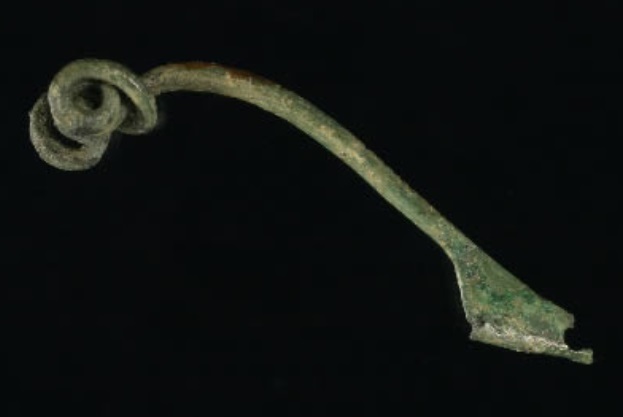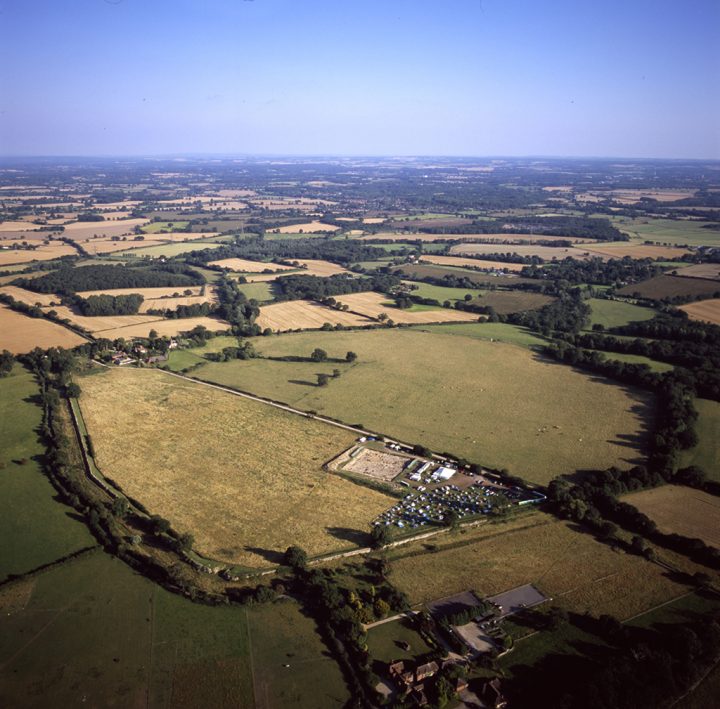Roman Finds
Pottery
Pottery formed the most abundant category of Roman material culture in the Victorian rubbish pit. As a collection it can be compared with May's catalogue of 19161 which includes mainly examples of complete vessels and highly decorated or distinctive sherds, such as, for example, of samian. The collection of material from our pit can be considered according to several principal categories.
Samian
The Victorian rubbish pit contained some 616 sherds of samian, approximately 17 per cent of the pottery assemblage.2 Relatively few mould-decorated sherds appear to have been discarded (50 decorated sherds as opposed to 566 fragments of plain ware). There is also a marked difference in the size of the discarded samian sherds; while the decorated fragments as a rule are quite small, it is striking how much highly diagnostic plain samian consisting of large sherds was discarded; in some cases almost half the vessel. It seems clear from May that makers' stamps on the base of plain samian vessels were actively searched out and kept by the Victorians. Only sixteen such base fragments with stamps were discarded into our pit and in all of these the stamp is incomplete and/or very worn. One samian counter was present.
Samian ware
Samian ware (or terra sigillata) is a high-quality red gloss tableware that was produced in huge quantities and distributed all over the empire. Due to its highly standardised out-put and the use of stamps, samian can be dated with a degree of accuracy unusual for pottery. Archaeologists commonly distinguish plain (wheel-made)and decorated (mould-made) samian.
Amphorae & Mortaria
Despite being large and thick-walled, and therefore easily identified in the ground, it is noticeable that the Victorians did not keep large and diagnostic fragments of amphorae. Seventeen handle, ten rim, two base and nineteen large wall sherds of amphorae (altogether representing 1.3 per cent of the assemblage), mainly of Dressel 20, were discarded. One faint graffito and a partially legible stamp were among this material.
The group of mortaria in the Victorian pit is characterised by thirty-eight large and highly diagnostic fragments (0.1 per cent of the pottery assemblage), mainly of Oxfordshire ware, and including one stamped rim. The bulk of the material can be dated to the 2nd and 3rd century. It is noticeable that there are diagnostic sherds of types not represented in May among this assemblage. This might suggest that the discard decision was based purely on size/completeness rather than typological considerations.
Amphorae
Amphorae are large vessels with two handles and a pointed base, used for the transportation and storage of perishable goods, in particular foodstuffs. The majority of the amphorae found in the Victorian rubbish pit were oil amphorae from southern Spain (Dressel 20s). These vessels have a large globular form, a thickened rounded or angular rim, and a distinctive plug of clay seals the base. Dressel 20s are commonly stamped, often on the top of the handle and occasionally on the neck or body. They also have painted inscriptions or occasional pre-firing graffiti, sometimes with dates.
A mortarium is a bowl with a prominent hooked flange and often a spout formed in the rim; it has grit embedded in the inner surface, and is thought to have been used as a grinding and mixing bowl for the preparation of food. Stamps may occur on the rim near the spout, and like samian, these can allow detailed studies of this ceramic industry.
Other Pottery
The pit contained over 150 sherds of other fine ware (0.4 per cent of the assemblage), mostly of Oxfordshire and New Forest wares. Additionally, some 2700 sherds of Romano-British coarse pottery, some being of substantial size are represented (75.9 per cent of the pottery assemblage), of which a relatively small amount is of first century date. Late third and fourth century pottery is also relatively uncommon with the bulk of the material belonging to the second or second/third century. Again, some fragments of special interest were discarded, for example a Terra Nigra-type plate with a damaged stamp as well as a New Forest red colour-coated bowl3 with a late Roman graffito (EB).
Bone and Shell
The Victorian rubbish pit contained some 350 animal bones. The assemblage is dominated by the leg and skull bones of cattle, but there are also sheep/goat and bird bones as well as two dog skulls and three dog mandibles. The most distinctive feature of the assemblage is the large number of horn cores of cattle (twenty-six fragments). There are also six fragments of antler. Some of the latter appear to show saw marks and might thus represent debris from bone and antler working. There are also eleven large oyster shells. Victorian excavation techniques would have favoured the recovery of mainly large and robust bones, but the range of species represented by the faunal remains from our pit corresponds with that reported from Roman rubbish pits during the Victorian excavations when species, but not their incidence, were noted.4 It is possible that there was also some preferential selection by the excavators of horn cores and dog skulls. The latter are particularly well represented in the Silchester Collection at Reading Museum which contains some 50 examples.
Stone
One whetstone fragment and three fragments of the upper stones of rotary querns were recovered from the rubbish pit. Although the Victorian excavators generally commented only on complete quern specimens, they also retained some small fragments which can be seen in the collection in Reading Museum. It is not clear why these particular examples were discarded but the fragmentary nature was evidently not the only deciding factor.
Ceramic Tile
Twenty-one kilograms of tile were recovered from the Victorian pit, of which the majority could not be confidently attributed to type. However, some 2kg were identified as fragments of tegulae, while 1kg comprised fragments of imbrex. Among the tiles were two fragments that bore animal footprints and one that preserved part of a hobnailed boot-impression. Such prints are well represented by the tiles in the Silchester Collection.5 In addition there were four fragments of chimney-pot.6 Although diagnostic, the fragments are small and, in contrast to the sole, but more complete example now in Reading Museum, were clearly not considered to be worth keeping.
Tile
There are two main types of tile: the tegula ( a large flat tile with flanges) and the imbrex (a long semi-circular tile that overlaid the adjoining flanges of the tegulae).
Please click here for more information about the chimney pot fragments.
Wall Plaster
Fifteen small fragments of wall plaster were found among the material in the pit. The majority (12 fragments) are painted red; there are two which show a red line on white ground and one which is green. Very few finds of painted wall plaster have so far been recovered from insula IX and it is likely therefore that these are part of the collection recovered from the pit at the northern end of House 2.7 The original excavation reports note that wall plaster is rare and that certain colours occur more frequently than others.8 In general, only those fragments which allow for the reconstruction of decorative patterns were recorded and preserved by the Victorians.
Glass
Apart from Victorian bottles, there were thirty fragments of Roman glass which can be dated to the 1st-late 2nd century AD.
Metalwork
Relatively little metalwork was discarded in the Victorian rubbish pit. There is one worn coin, two pin fragments, one stud as well as some small fragments, which might be modern. More remarkable are an incomplete bronze "cable" bracelet9 and three very fragmentary (Nauheim derivatives) brooches. About 50 iron nails in relatively good condition were also discarded.



